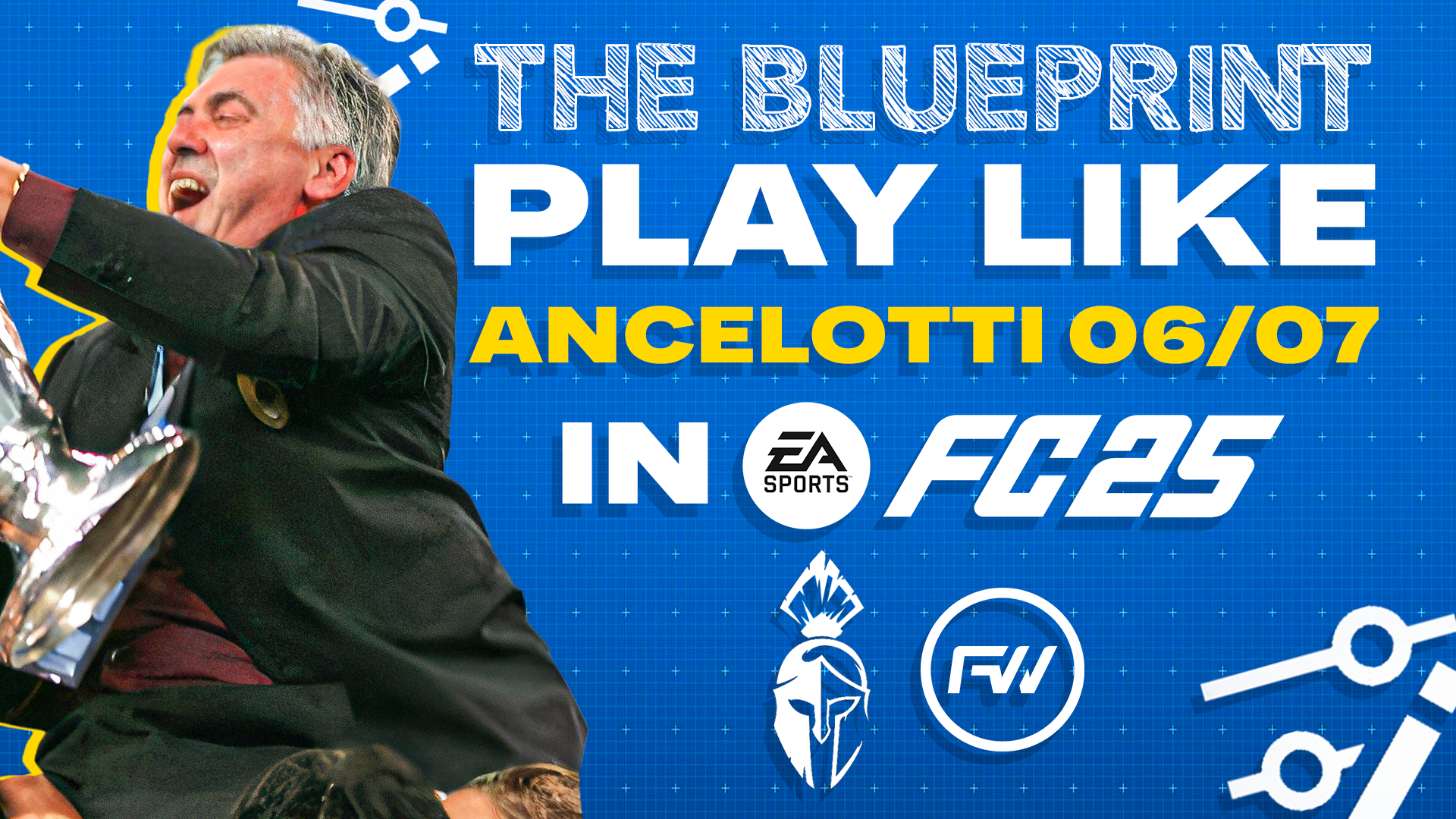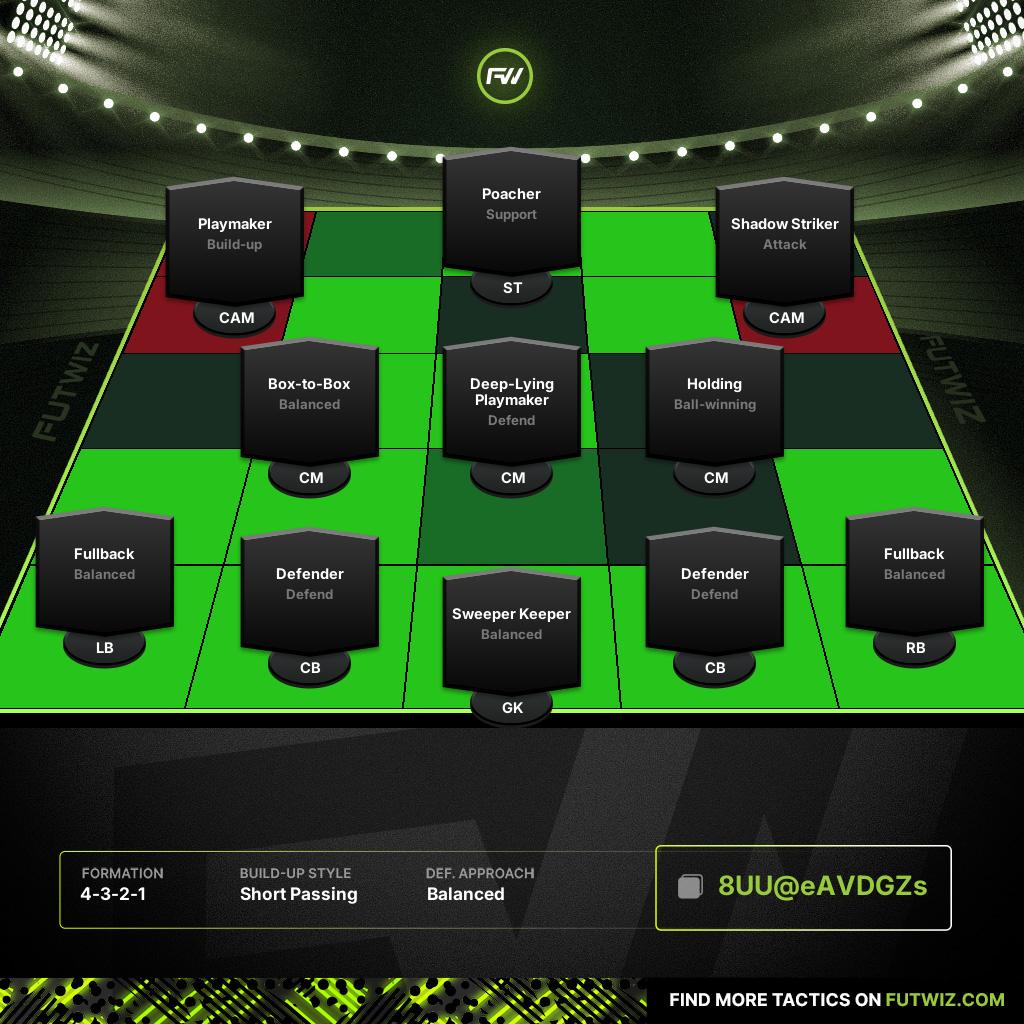Welcome to The Blueprint. A weekly series where myself (pauciloquxnt) and FUTWIZ will be venturing into the world of real life tactics and how we can recreate them in FC 25. This week we’ll be looking at Carlo Ancelotti’s AC Milan side from the 2006/07 season—a team built on experience, tactical discipline, and the brilliance of Kaká. Hope you enjoy it!

AC Milan 2006/07 – Control, Class & Kaká’s Brilliance
The 2006/07 season was a defining one for Carlo Ancelotti’s Milan. Despite finishing fourth in Serie A due to an eight-point deduction for their part in the Calciopoli scandal, Milan conquered Europe, lifting the UEFA Champions League trophy with a 2-1 win over Liverpool in the final—avenging their heartbreak in Istanbul two years earlier.
At the heart of their success was Kaká, who delivered one of the all-time great Champions League campaigns. His combination of creativity, athleticism, and end product made him unplayable, securing his place as Europe’s best player.
Tactical Framework
Formation & Build-Up Play
Milan primarily operated in a 4-3-2-1 (Christmas Tree) formation, designed to control possession and dominate the midfield. The system allowed for fluid transitions between phases while keeping a strong defensive core.
- Backline Composure: The experienced duo of Alessandro Nesta and Paolo Maldini marshalled the defence, providing leadership and calmness. Full-backs Massimo Oddo and Marek Jankulovski offered width but picked their moments to advance.
- Midfield Control: The trio of Andrea Pirlo, Gennaro Gattuso, and Massimo Ambrosini formed a perfect balance. Pirlo dictated the tempo from deep, Ambrosini provided physicality and box-to-box presence, while Gattuso was the relentless ball-winner protecting the back four.
- Creative Link: Clarence Seedorf and Kaká operated as dual attacking midfielders, with the freedom to roam and create. Kaká regularly pushed higher to support Filippo Inzaghi, while Seedorf drifted wide or deeper to maintain balance.
Milan’s build-up was methodical, often starting with Pirlo dropping deep to collect possession and dictate play. Their patience in possession created openings for Kaká and Seedorf to exploit between the lines.
Defensive Organisation and Pressing
While Milan didn’t press with the same intensity as modern teams such as Klopp’s Liverpool, their defensive organisation was world-class:
- Structured Mid-Block: Milan defended in a compact 4-3-2-1 shape, making it difficult for opponents to play through the middle.
- Controlled Pressing: Gattuso was the primary presser, stepping out to disrupt build-up, while Ambrosini supported and covered space.
- Experienced Backline: Nesta and Maldini’s leadership ensured Milan rarely got stretched, using smart positioning rather than pure athleticism.
This control-first approach allowed Milan to absorb pressure and hit teams on the break, particularly through Kaká’s devastating dribbling.
Attacking Play & Goal Threat
Milan’s attack was built on patience, precision, and individual brilliance rather than sheer pace or volume of attacks.
- Kaká’s Direct Runs: Often, Milan’s most dangerous moments came from Kaká driving through midfield. His ability to carry the ball 30-40 yards under pressure broke defensive lines and created overloads.
- Seedorf’s Intelligence: Seedorf supported attacks with clever positioning, offering a passing option wide or centrally while linking with Pirlo and Kaká.
- Inzaghi’s Poaching Instinct: Inzaghi remained high, always looking to exploit defensive gaps. He wasn’t involved in the build-up but was lethal in the box—scoring both goals in the final against Liverpool.
- Wide Overloads: Jankulovski and Oddo provided width when needed, delivering crosses or pulling defenders out to open space centrally.
Milan’s measured attacking approach yielded 20 goals in 13 Champions League matches, often striking at the perfect moment in big games.
Kaká – Europe’s Best Player and Ballon d’Or Winner
While Milan’s system was built on collective experience and control, Kaká’s individual brilliance was undeniable. He finished the 2006/07 Champions League campaign as the tournament’s top scorer with 10 goals, driving Milan to their seventh European title and earning himself global recognition.
Key Aspects of Kaká’s Role
- The Creative Force and Goal Threat
Kaká operated between the lines, consistently driving at defences and scoring crucial goals. His 10-goal haul included brilliant performances against Celtic, Bayern Munich, and a sensational semi-final display against Manchester United.
2. Ball-Carrying and Transition Play
Milan’s most dangerous transitions came through Kaká’s ball-carrying. His pace and technical quality allowed him to bypass players with ease, often turning defence into attack single-handedly.
3. Big Game Impact
Kaká thrived in the biggest moments. Against Manchester United, he scored three goals across two legs—including a stunning solo effort at Old Trafford. In the final, his perfect through ball set up Inzaghi’s second goal, sealing the win.
4. Recognition – Ballon d’Or Winner
Kaká’s performances were so outstanding that he was later crowned the 2007 Ballon d’Or winner—becoming the last player to win the award before Messi and Ronaldo’s era of dominance. His season was the complete package: goals, creativity, leadership, and consistency at the highest level.
Alessandro Nesta & Andrea Pirlo – Milan’s Pillars of Control
Beyond Kaká’s brilliance, Milan’s success was built on the calm authority of Alessandro Nesta and the deep-lying playmaking of Andrea Pirlo.
- Nesta: The Italian centre-back was immense throughout the campaign—organising the backline, reading the game perfectly, and winning key duels. His composure under pressure was vital, especially in knockout ties.
- Pirlo: Pirlo’s control from deep allowed Milan to dictate the tempo of every game. With 85% pass accuracy in the Champions League, he connected defence to attack, released Kaká and Seedorf, and ensured Milan dominated possession when needed.
Together, they provided the balance and leadership that allowed Milan to execute Ancelotti’s tactical blueprint perfectly.
Statistical Insights & Achievements
Milan’s incredible campaign was reflected in the stats:
Achievements
- Champions League Winners – Defeated Liverpool 2-1 in the final.
- 4th in Serie A – Secured UCL qualification despite an 8-point deduction from the Calciopoli scandal.
- Top Scorer in UCL – Kaká (10 goals), Champions League Golden Boot winner.
Key Stats
- Kaká: 10 UCL goals, 3 assists – Named UEFA Club Footballer of the Year.
- Filippo Inzaghi: Scored 4 UCL goals, including both in the final.
- Alessandro Nesta: 43 clearances in the UCL knockout rounds.
- Andrea Pirlo: 85% pass completion in UCL, 4 assists.
- Milan Defence: Conceded just 9 goals in 13 UCL matches.
Recreated for FC 25

Make sure to check out the full tactic on FUTWIZ
The Tactics
Build-Up Style is set to Short Passing. This Milan team were considered in their approach, cycling the ball well and looking for the opportune moment to strike.
Line Height is set to 50. Ancelotti didn’t favour a high press, rather allowing his team to reset when they lost the ball, except Gattuso who was the destroyer in midfield.
The GK is set to Sweeper Keeper with a Balanced focus. Dida made sure that he got out to any loose balls, but didn’t go much further than that with the build-up.
The LB and RB are set to Fullback with a Balanced focus. Oddo and Jankulovski weren’t the kind of wing-backs we see today that have a lot of attacking prowess. However they could contribute when called upon.
Both CBs are set to Defender with a Defend focus. Nesta and Maldini formed arguably the strongest centre-back partnership in world football, with an aging Maldini offering experience and guile, and Nesta’s ability to read the game meaning Milan were solid defensively.
The central CM is set to Deep-Lying Playmaker with a Defend focus. Pirlo – the Regista. Orchestrating play from deep, not really progressing too far up the pitch, but with great vision and an incredible passing range. This player is going to make everything tick.
The right CM is set to Holding with a Ball-Winning focus. Gattuso was the bulldog in this midfield, pressing opponents as they approached Milan’s half, putting in crunching tackles and generally being a nuisance to the opponent.
The left CM is set to Box to Box with a Balanced focus. Ambrosini played a more B2B role in this midfield, supporting Seedorf ahead of him, and also making late runs into the box to add a goal threat from midfield.
The right CAM is set to Shadow Striker with an Attack focus. Kaká was the mercurial talent at the heart of this Milan team’s success. Comfortable dropping deep to support build up, but most lethal when supporting the striker with his powerful runs and precise finishing.
The left CAM is set to Playmaker with a Build-Up focus. Seedorf would often drop deeper into a more traditional LM area in build up, to provide some artificial width to a narrow formation. This would ensure there was a smooth link up from midfield to attack.
The ST is set to Poacher with a Support focus. Inzaghi was a poacher in every sense of the word, played on the shoulder of the last defender, offside a fair bit, but had the movement and intelligence to get himself into the right position more often than not, and when he did, he was clinical.
Tips and Tricks
– Situational use of L1 triggers will help you overload the wings. Don’t overuse it, make sure you vary your attacks, but it can help you gain a crucial extra man in attacking areas.
– SLOW DOWN! This tactic will not work if you play at 100mph. You need to be patient, and considered in your approach.
– The DLP CM needs to have as many passing playstyles as possible. They will be your creative fulcrum, keeping everything ticking.
– Have a very good ball carrier as your Shadow Striker, Kaká was well known for carrying the ball 50-60 yards at times, so have someone you’re confident with, that has speed, technique and power!
– Not having a DM may be something you need to get used to, you may feel ‘naked’ at the back. Don’t panic, just bring your CMs deeper manually, and utilise your second man press to close down the opponent.
Conclusion
AC Milan’s 2006/07 season was a tactical masterclass, built on experience, control, and Kaká’s brilliance. Their Champions League triumph showcased Ancelotti’s ability to balance defensive solidity with moments of attacking genius.
Kaká’s evolution into Europe’s most dominant player—capped with the Ballon d’Or—was the driving force behind Milan’s success. His unique blend of athleticism, technical quality, and decisive output made Milan unplayable in key moments, particularly in their run through the knockout rounds.
While their domestic form stuttered, Milan’s European campaign was a perfect storm of elite experience and individual brilliance, cementing their status as one of the most iconic sides of the modern era.
Check out the full Thread on X here


Comments